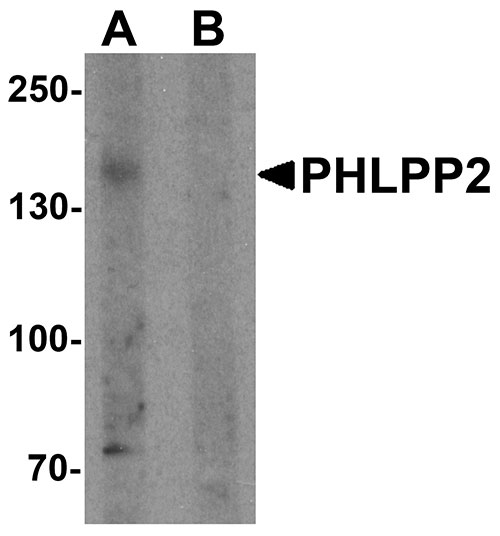PHLPP2 Antibody
- 产品详情
- 实验流程
- 背景知识
Application
| WB, IF, ICC, E |
|---|---|
| Primary Accession | Q6ZVD8 |
| Other Accession | NP_055835, 65301141 |
| Reactivity | Human |
| Host | Rabbit |
| Clonality | Polyclonal |
| Isotype | IgG |
| Calculated MW | 146751 Da |
| Concentration (mg/ml) | 1 mg/mL |
| Conjugate | Unconjugated |
| Application Notes | PHLPP2 antibody can be used for detection of PHLPP2 by Western blot at 1 µg/mL. |
| Gene ID | 23035 |
|---|---|
| Other Names | PH domain leucine-rich repeat-containing protein phosphatase 2, 3.1.3.16, PH domain leucine-rich repeat-containing protein phosphatase-like, PHLPP-like, PHLPP2, KIAA0931, PHLPPL |
| Target/Specificity | PHLPP2; At least three isoforms are known to exist; this antibody will detect the two largest isoforms. PHLPP2 antibody is predicted to not cross react with PHLPP1. |
| Reconstitution & Storage | PHLPP2 antibody can be stored at 4℃ for three months and -20℃, stable for up to one year. As with all antibodies care should be taken to avoid repeated freeze thaw cycles. Antibodies should not be exposed to prolonged high temperatures. |
| Precautions | PHLPP2 Antibody is for research use only and not for use in diagnostic or therapeutic procedures. |
| Name | PHLPP2 |
|---|---|
| Synonyms | KIAA0931, PHLPPL |
| Function | Protein phosphatase involved in regulation of Akt and PKC signaling. Mediates dephosphorylation in the C-terminal domain hydrophobic motif of members of the AGC Ser/Thr protein kinase family; specifically acts on 'Ser-473' of AKT1, 'Ser-660' of PRKCB isoform beta-II and 'Ser-657' of PRKCA. Akt regulates the balance between cell survival and apoptosis through a cascade that primarily alters the function of transcription factors that regulate pro- and antiapoptotic genes. Dephosphorylation of 'Ser-473' of Akt triggers apoptosis and decreases cell proliferation. Also controls the phosphorylation of AKT3. Dephosphorylates STK4 on 'Thr-387' leading to STK4 activation and apoptosis (PubMed:20513427). Dephosphorylates RPS6KB1 and is involved in regulation of cap-dependent translation (PubMed:21986499). Inhibits cancer cell proliferation and may act as a tumor suppressor. Dephosphorylation of PRKCA and PRKCB leads to their destabilization and degradation. Dephosphorylates RAF1 inhibiting its kinase activity (PubMed:24530606). |
| Cellular Location | Cytoplasm. Membrane; Peripheral membrane protein. Nucleus. Note=In colorectal cancer tissue, expression is concentrated in the cytoplasm and nucleus |
| Tissue Location | In colorectal cancer tissue, expression is highest in the surface epithelium of normal colonic mucosa adjacent to the cancer tissue but is largely excluded from the crypt bases. Expression is lost or significantly decreased in 80% of tested tumors (at protein level). |
For Research Use Only. Not For Use In Diagnostic Procedures.
Provided below are standard protocols that you may find useful for product applications.
BACKGROUND
PHLPP2 Antibody: PHLPP2 is a member of the serine/threonine phosphatase family, which are important regulators of Akt serine-threonine kinases (AKT1, AKT2, AKT3) and conventional/novel protein kinase C (PKC) isoforms. PHLPP1 and PHLPP2 have a similar domain structure and have been shown to dephosphorylate and inactivate, distinct Akt isoforms, at one of the two critical phosphorylation sites required for activation: Serine473. PHLPP2 dephosphorylates AKT1 and AKT3, whereas PHLPP1 is specific for AKT2 and AKT3. PHLPP1 promotes apoptosis and may act as a tumor suppressor. PHLPP2 associates with and is inhibited by adenylyl cyclase type 6 (AC6), thereby allowing Akt activation.
REFERENCES
Brognard J and Newton AC. PHLiPPing the switch on Akt and protein kinase C signaling. Trends Endocrinol. Metab. 2008; 19:223-30.
Gao T, Furnari F and Newton AC. PHLPP: a phosphatase that directly dephosphorylates Akt, promotes apoptosis, and suppresses tumor growth. Mol. Cell 2005; 18:13-24.
Brognard J, Sierecki E, Gao T, et al. PHLPP and a second isoform, PHLPP2, differentially attenuate the amplitude of Akt signaling by regulating distinct Akt isoforms. Mol. Cell 2007; 25:917-31
Gao MH, Miyanohara A, Feramisco JR, et al. Activation of PH-domain leucine-rich protein phosphatase 2 (PHLPP2) by agonist stimulation in cardiac myocytes expressing adenylyl cyclase type 6. Biochem. Biophys. Res. Commun. 2009; 384:193-8.
终于等到您。ABCEPTA(百远生物)抗体产品。
点击下方“我要评价 ”按钮提交您的反馈信息,您的反馈和评价是我们最宝贵的财富之一,
我们将在1-3个工作日内处理您的反馈信息。
如有疑问,联系:0512-88856768 tech-china@abcepta.com.























 癌症的基本特征包括细胞增殖、血管生成、迁移、凋亡逃避机制和细胞永生等。找到癌症发生过程中这些通路的关键标记物和对应的抗体用于检测至关重要。
癌症的基本特征包括细胞增殖、血管生成、迁移、凋亡逃避机制和细胞永生等。找到癌症发生过程中这些通路的关键标记物和对应的抗体用于检测至关重要。 为您推荐一个泛素化位点预测神器——泛素化分析工具,可以为您的蛋白的泛素化位点作出预测和评分。
为您推荐一个泛素化位点预测神器——泛素化分析工具,可以为您的蛋白的泛素化位点作出预测和评分。 细胞自噬受体图形绘图工具为你的蛋白的细胞受体结合位点作出预测和评分,识别结合到自噬通路中的蛋白是非常重要的,便于让我们理解自噬在正常生理、病理过程中的作用,如发育、细胞分化、神经退化性疾病、压力条件下、感染和癌症。
细胞自噬受体图形绘图工具为你的蛋白的细胞受体结合位点作出预测和评分,识别结合到自噬通路中的蛋白是非常重要的,便于让我们理解自噬在正常生理、病理过程中的作用,如发育、细胞分化、神经退化性疾病、压力条件下、感染和癌症。








